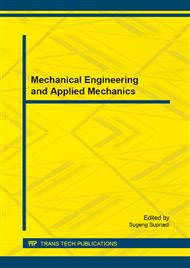p.45
p.51
p.57
p.63
p.71
p.77
p.83
p.89
p.95
Performance Analysis of 3-URU Spherical Parallel Mechanism Designed Based on Velocity Transmission and Force Constraint Indices
Abstract:
In this paper was observed performances of developed three degrees of freedom (dof) parallel mechanism named 3-URU spherical parallel mechanism. The mechanism is composed of three identical limbs mounted symmetrically to base (fixed link) and platform (output link). The limb is constructed by universal-revolute and universal joints. The kinematic constants of mechanism consisting of link lengths, radius of platform, radius of base, mounting angle of limb and platform to base and platform were determined with consideration of velocity transmission and force constraint indices. To evaluate performance of mechanism, it was manufactured a prototype of mechanism designed base on these two mentioned indices. There are three steps proposed to realize the mechanism, (i) kinematic synthesis to determine of kinematic constants, (ii) design of mechanical components to define shape and dimension of links and joints by considering collision in wokingspace and static analysis, (iii) evaluation of mechanism performances consisting of workingspace, controllability of platform motion and static payload. Based on obtained results, it can be clarified that, the mechanism can produce spherical motion of platform which rotates on steady point recognized as center of platform rotation. The platform can achieve maximum inclination angle, 80 degree and at this posture occurs translational error, 0.0102 mm. On the other hand, the mechanism can support payload ten times of weight of moving parts.
Info:
Periodical:
Pages:
71-76
Citation:
Online since:
April 2015
Authors:
Price:
Сopyright:
© 2015 Trans Tech Publications Ltd. All Rights Reserved
Share:
Citation:


